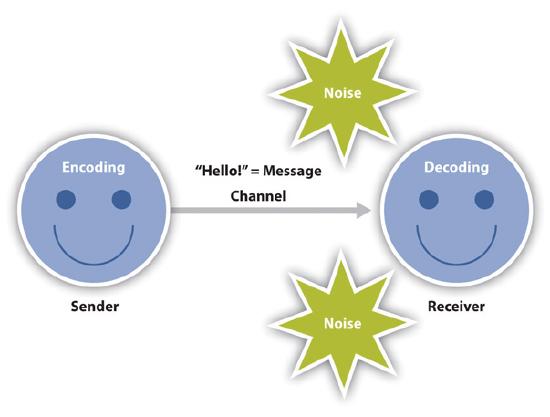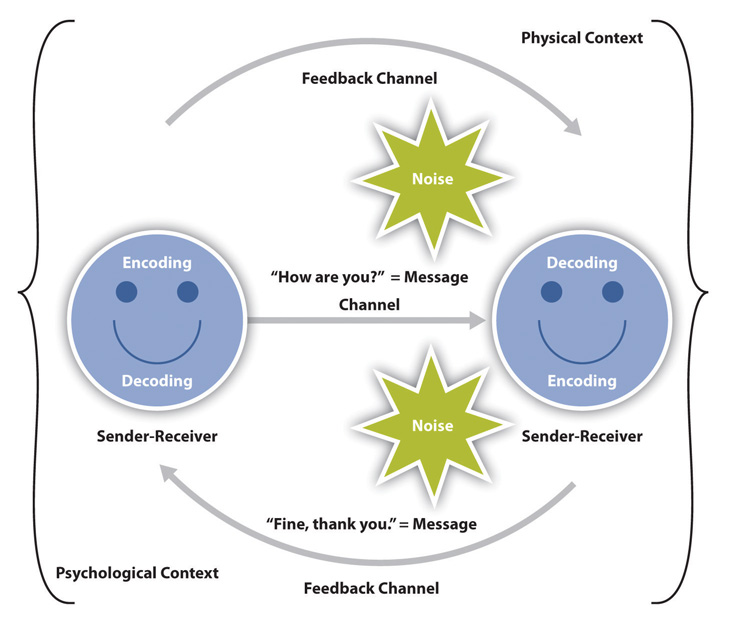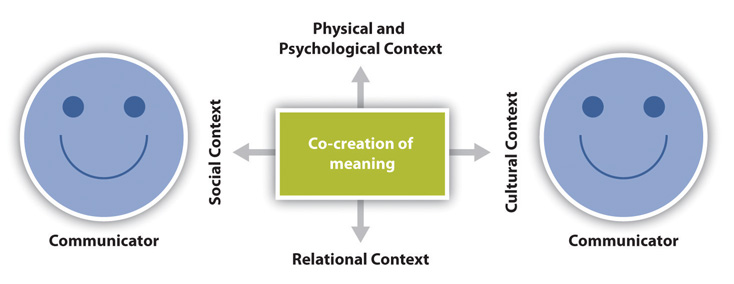1.2: The Communication Process
- Last updated
- Save as PDF
- Page ID
- 23966

- Anonymous
- LibreTexts
Learning Objectives
- Identify and define the components of the transmission model of communication.
- Identify and define the components of the interaction model of communication.
- Identify and define the components of the transaction model of communication.
- Compare and contrast the three models of communication.
- Use the transaction model of communication to analyze a recent communication encounter.
Communication is a complex precess and it is difficult to determine where or with whom a communication encounter starts and ends. Models of communication simplify the process by providing a visual representation of the various aspects of a communication encounter. Models serve a valuable purpose for students of communication because they allow us to see specific concepts and steps within the process of communication, define communication, and apply communication concepts. The three models of communication we will discuss are the transmission, interaction, and transaction models.
In communication models, the participants are the senders and/or receivers of messages in a communication encounter. The message is the verbal or nonverbal content being conveyed from sender to receiver. Encoding is the process of turning thoughts into communication. Of course, we don’t just communicate verbally—we have various options, or channels for communication. Encoded messages are sent through a channel, or a sensory route on which a message travels, to the receiver for decoding. While communication can be sent and received using any sensory route (sight, smell, touch, taste, or sound), most communication occurs through visual (sight) and/or auditory (sound) channels. If your roommate has headphones on and is engrossed in a video game, you may need to get his attention by waving a beer in front of him before you can ask him about dinner.
Transmission Model of Communication
The transmission model of communication describes communication as a linear, one-way process in which a sender intentionally transmits a message to a receiver (Ellis & McClintock, 1990). This model focuses on the sender and message within a communication encounter. Although the receiver is included in the model, this role is viewed as more of a target or end point rather than part of an ongoing process. We are left to presume that the receiver either successfully receives and understands the message or does not.

Since this model is sender and message focused, responsibility is put on the sender to help ensure the message is successfully conveyed. Noise is anything that interferes with a message being sent between participants in a communication encounter. Even if a speaker sends a clear message, noise may interfere with a message being accurately received and decoded. The transmission model of communication accounts for environmental and semantic noise. Environmental noise is any physical noise present in a communication encounter. Other people talking in a crowded diner could interfere with your ability to transmit a message and have it successfully decoded. While environmental noise interferes with the transmission of the message, semantic noise refers to noise that occurs in the encoding and decoding process when participants do not understand a symbol. For example, most French speakers can’t decode Swedish and vice versa. Semantic noise can also interfere in communication between people speaking the same language because many words have multiple or unfamiliar meanings.
This model is not quite rich enough to capture dynamic face-to-face interactions, but there are instances in which communication is one-way and linear, especially computer-mediated communication (CMC). As the following “Getting Plugged In” box explains, CMC is integrated into many aspects of our lives now and has opened up new ways of communicating and brought some new challenges. Think of text messaging for example. The transmission model of communication is well suited for describing the act of text messaging since the sender isn’t sure that the meaning was effectively conveyed or that the message was received at all. Noise can also interfere with the transmission of a text. If you use an abbreviation the receiver doesn’t know or the phone autocorrects to something completely different than you meant, then semantic noise has interfered with the message transmission.
“Getting Plugged In”
Computer-Mediated Communication
When the first computers were created around World War II and the first e-mails exchanged in the early 1960s, we took the first steps toward a future filled with computer-mediated communication (CMC) (Thurlow, Lengel, & Tomic, 2004). Those early steps turned into huge strides in the late 1980s and early 1990s when personal computers started becoming regular features in offices, classrooms, and homes. I remember getting our first home computer, a Tandy from Radio Shack, in the early 1990s and then getting our first Internet connection at home in about 1995. I set up my first e-mail account in 1996 and remember how novel and exciting it was to send and receive e-mails. I wasn’t imagining a time when I would get dozens of e-mails a day, much less be able to check them on my cell phone! Many of you reading this book probably can’t remember a time without CMC. If that’s the case, then you’re what some scholars have called “digital natives.” When you take a moment to think about how, over the past twenty years, CMC has changed the way we teach and learn, communicate at work, stay in touch with friends, initiate romantic relationships, search for jobs, manage our money, get our news, and participate in our democracy, it really is amazing to think that all that used to take place without computers. But the increasing use of CMC has also raised some questions and concerns, even among those of you who are digital natives. Almost half of the students in my latest communication research class wanted to do their final research projects on something related to social media. Many of them were interested in studying the effects of CMC on our personal lives and relationships. This desire to study and question CMC may stem from an anxiety that people have about the seeming loss or devaluing of face-to-face (FtF) communication. Aside from concerns about the digital cocoons that many of us find ourselves in, CMC has also raised concerns about privacy, cyberbullying, and lack of civility in online interactions. We will continue to explore many of these issues in the “Getting Plugged In” feature box included in each chapter, but the following questions will help you begin to see the influence that CMC has in your daily communication.
- In a typical day, what types of CMC do you use?
- What are some ways that CMC reduces stress in your life? What are some ways that CMC increases stress in your life? Overall, do you think CMC adds to or reduces your stress more?
- Do you think we, as a society, have less value for FtF communication than we used to? Why or why not?
Interaction Model of Communication
The interaction model of communication describes communication as a process in which participants alternate positions as sender and receiver and generate meaning by sending messages and receiving feedback within physical and psychological contexts (Schramm, 1997). The interaction model incorporates feedback, which makes communication a more interactive, two-way process. Feedback includes messages sent in response to other messages. Rather than having one sender, one message, and one receiver, this model has two sender-receivers who exchange messages. Each participant alternates roles as sender and receiver in order to keep a communication encounter going.
The interaction model is also less message focused and more interaction focused. The interaction model is more concerned with the communication process itself. In fact, this model acknowledges that there are so many messages being sent at one time that many of them may not even be received.
Figure 1.2 The Interaction Model of Communication

The interaction model takes physical and psychological context into account. Physical context includes the environmental factors in a communication encounter. The size, layout, temperature, and lighting of a space influence our communication. Whether it’s the size of the room, the temperature, or other environmental factors, it’s important to consider the role that physical context plays in our communication.
Psychological context includes the mental and emotional factors in a communication encounter. Stress, anxiety, and emotions are just some examples of psychological influences that can affect our communication. Feedback and context help make the interaction model a more useful illustration of the communication process, but the transaction model views communication as a powerful tool that shapes our realities beyond individual communication encounters.
Transaction Model of Communication
The transaction model differs from the transmission and interaction models in significant ways including the conceptualization of communication, the role of sender and receiver, and the role of context. (Barnlund, 1970)
The transaction model of communication describes communication as a process in which communicators generate social realities within social, relational, and cultural contexts. In this model, we don’t just communicate to exchange messages; we communicate to create relationships, form intercultural alliances, shape our self-concepts, and engage with others in dialogue to create communities. In short, we don’t communicate about our realities; communication helps to construct our realities.
The roles of sender and receiver in the transaction model of communication differ significantly from the other models. Instead of labeling participants as senders and receivers, the people in a communication encounter are referred to as communicators. The transaction model suggests that we are simultaneously senders and receivers. This is an important addition to the model because it allows us to understand how we are able to adapt our communication—for example, a verbal message—in the middle of sending it based on the communication we are simultaneously receiving from our communication partner.
Figure 1.3 The Transaction Model of Communication

The transaction model also includes a more complex understanding of context. Since the transaction model of communication views communication as a force that shapes our realities before and after specific interactions occur, it must account for contextual influences outside of a single interaction. To do this, the transaction model considers how social, relational, and cultural contexts frame and influence our communication encounters.
Social context refers to the stated rules or unstated norms that guide communication. As we are socialized into our various communities, we learn rules and implicitly pick up on norms for communicating. Some common rules that influence social contexts include don’t lie to people, don’t interrupt people, don’t pass people in line, greet people when they greet you, thank people when they pay you a compliment, and so on.
Norms are social conventions that we pick up on through observation, practice, and trial and error. We may not even know we are breaking a social norm until we notice people looking at us strangely or someone corrects or teases us. Even though breaking social norms doesn’t result in the formal punishment that might be a consequence of breaking a social rule, the social awkwardness we feel when we violate social norms is usually enough to teach us that these norms are powerful even though they aren’t made explicit like rules. Norms even have the power to override social rules in some situations. We may break the rule about not lying if the lie is meant to save someone from feeling hurt. We often interrupt close friends when we’re having an exciting conversation, but we wouldn’t be as likely to interrupt our manager when she is talking at a team meeting. Since norms and rules vary among people and cultures, relational and cultural contexts are also included in the transaction model in order to help us understand the multiple contexts that influence our communication.
Relational context includes the previous interpersonal history and type of relationship we have with a person. We communicate differently with someone we just met versus someone we’ve known for a long time. Since communication norms and rules also vary based on the type of relationship people have, relationship type is also included in relational context. For example, there are certain communication rules and norms that apply to a supervisor-supervisee relationship that don’t apply to a brother-sister relationship and vice versa. Just as social norms and relational history influence how we communicate, so does culture.
Cultural context includes various aspects of identities such as race, gender, nationality, ethnicity, sexual orientation, class, and ability. For now it is important for us to understand that whether we are aware of it or not, we all have multiple cultural identities that influence our communication. Some people, especially those with identities that have been historically marginalized, are regularly aware of how their cultural identities influence their communication and influence how others communicate with them. Conversely, people with identities that are dominant or in the majority may rarely, if ever, think about the role their cultural identities play in their communication.

Cultural context is influenced by numerous aspects of our identities and is not limited to race or ethnicity.
Wikimedia Commons – public domain.
Since intercultural communication creates uncertainty, it can deter people from communicating across cultures or lead people to view intercultural communication as negative. But if you avoid communicating across cultural identities, you will likely not get more comfortable or competent as a communicator. Intercultural communication has the potential to enrich various aspects of our lives. In order to communicate well within various cultural contexts, it is important to keep an open mind and avoid making assumptions about others’ cultural identities. While you may be able to identify some aspects of the cultural context within a communication encounter, there may also be cultural influences that you can’t see. A competent communicator shouldn’t assume to know all the cultural contexts a person brings to an encounter, since not all cultural identities are visible. As with the other contexts, it requires skill to adapt to shifting contexts, and the best way to develop these skills is through practice and reflection.
Key Takeaways
- Communication models are not complex enough to truly capture all that takes place in a communication encounter, but they can help us examine the various steps in the process in order to better understand our communication and the communication of others.
- The transmission model of communication describes communication as a one-way, linear process in which a sender encodes a message and transmits it through a channel to a receiver who decodes it. The transmission of the message many be disrupted by environmental or semantic noise. This model is usually too simple to capture FtF interactions but can be usefully applied to computer-mediated communication.
- The interaction model of communication describes communication as a two-way process in which participants alternate positions as sender and receiver and generate meaning by sending and receiving feedback within physical and psychological contexts. This model captures the interactive aspects of communication but still doesn’t account for how communication constructs our realities and is influenced by social and cultural contexts.
- The transaction model of communication describes communication as a process in which communicators generate social realities within social, relational, and cultural contexts. This model includes participants who are simultaneously senders and receivers and accounts for how communication constructs our realities, relationships, and communities.
Exercise
- Use the transaction model of communication to analyze a recent communication encounter you had. Sketch out the communication encounter and make sure to label each part of the model (communicators; message; channel; feedback; and physical, psychological, social, relational, and cultural contexts).
References
Barnlund, D. C., “A Transactional Model of Communication,” in Foundations of Communication Theory, eds. Kenneth K. Sereno and C. David Mortensen (New York, NY: Harper and Row, 1970), 83–92.
Ellis, R. and Ann McClintock, You Take My Meaning: Theory into Practice in Human Communication (London: Edward Arnold, 1990), 71.
Schramm, W., The Beginnings of Communication Study in America (Thousand Oaks, CA: Sage, 1997).
Shannon, C. and Warren Weaver, The Mathematical Theory of Communication (Urbana, IL: University of Illinois Press, 1949), 16.
Thurlow, C., Laura Lengel, and Alice Tomic, Computer Mediated Communication: Social Interaction and the Internet (London: Sage, 2004), 14.

